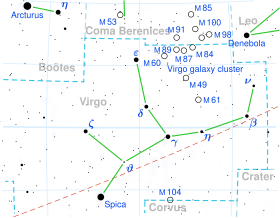Binary star in the constellation Virgo
Pi Virginis (π Vir, π Virginis) is a binary star in the zodiac constellation of Virgo . It is visible to the naked eye with an apparent visual magnitude of 4.64.[ 2] parallax measurements,[ 1] light years .
This is a spectroscopic binary system with a stellar classification of A5V. They have an orbital period of 283 days with an eccentricity of 0.27.[ 7] Am star .[ 9]
References
^ a b c d e f van Leeuwen, F. (November 2007), "Validation of the new Hipparcos reduction", Astronomy and Astrophysics , 474 (2): 653–664, arXiv :0708.1752 Bibcode :2007A&A...474..653V , doi :10.1051/0004-6361:20078357 , S2CID 18759600 . ^ a b c d Mermilliod, J.-C. (1986), "Compilation of Eggen's UBV data, transformed to UBV (unpublished)", Catalogue of Eggen's UBV Data , Bibcode :1986EgUBV........0M . ^ a b Royer, F.; et al. (February 2007), "Rotational velocities of A-type stars. III. Velocity distributions", Astronomy and Astrophysics , 463 (2): 671–682, arXiv :astro-ph/0610785 Bibcode :2007A&A...463..671R , doi :10.1051/0004-6361:20065224 , S2CID 18475298 . ^ Evans, D. S. (June 20–24, 1966), Batten, Alan Henry; Heard, John Frederick (eds.), "The Revision of the General Catalogue of Radial Velocities", Determination of Radial Velocities and their Applications, Proceedings from IAU Symposium no. 30 , vol. 30, University of Toronto: International Astronomical Union , p. 57, Bibcode :1967IAUS...30...57E . ^ Anderson, E.; Francis, Ch. (2012), "XHIP: An extended hipparcos compilation", Astronomy Letters , 38 (5): 331, arXiv :1108.4971 Bibcode :2012AstL...38..331A , doi :10.1134/S1063773712050015 , S2CID 119257644 . ^ ESA (1997). "The Hipparcos and Tycho Catalogues". VizieR On-line Data Catalog . Bibcode :1997yCat.1239....0E . ^ a b c Ducati, J. R.; et al. (January 2011), "The mass ratio and initial mass functions in spectroscopic binaries" (PDF) , Astronomy and Astrophysics , 525 : 9, Bibcode :2011A&A...525A..26D , doi :10.1051/0004-6361/200913895 ^ Pasinetti Fracassini, L. E.; et al. (February 2001), "Catalogue of Apparent Diameters and Absolute Radii of Stars (CADARS) - Third edition - Comments and statistics", Astronomy and Astrophysics , 367 (2): 521–524, arXiv :astro-ph/0012289 Bibcode :2001A&A...367..521P , doi :10.1051/0004-6361:20000451 , S2CID 425754 . ^ a b c Paunzen, E.; et al. (February 2013), "A photometric study of chemically peculiar stars with the STEREO satellites - II. Non-magnetic chemically peculiar stars", Monthly Notices of the Royal Astronomical Society , 429 (1): 119–125, arXiv :1211.1535 Bibcode :2013MNRAS.429..119P , doi :10.1093/mnras/sts318 S2CID 119231581 . ^ "pi. Vir -- Spectroscopic binary" , SIMBAD Astronomical Database , Centre de Données astronomiques de Strasbourg, retrieved 2016-09-16 .
